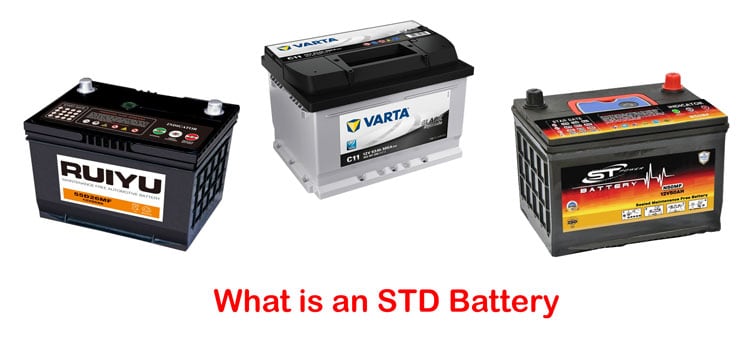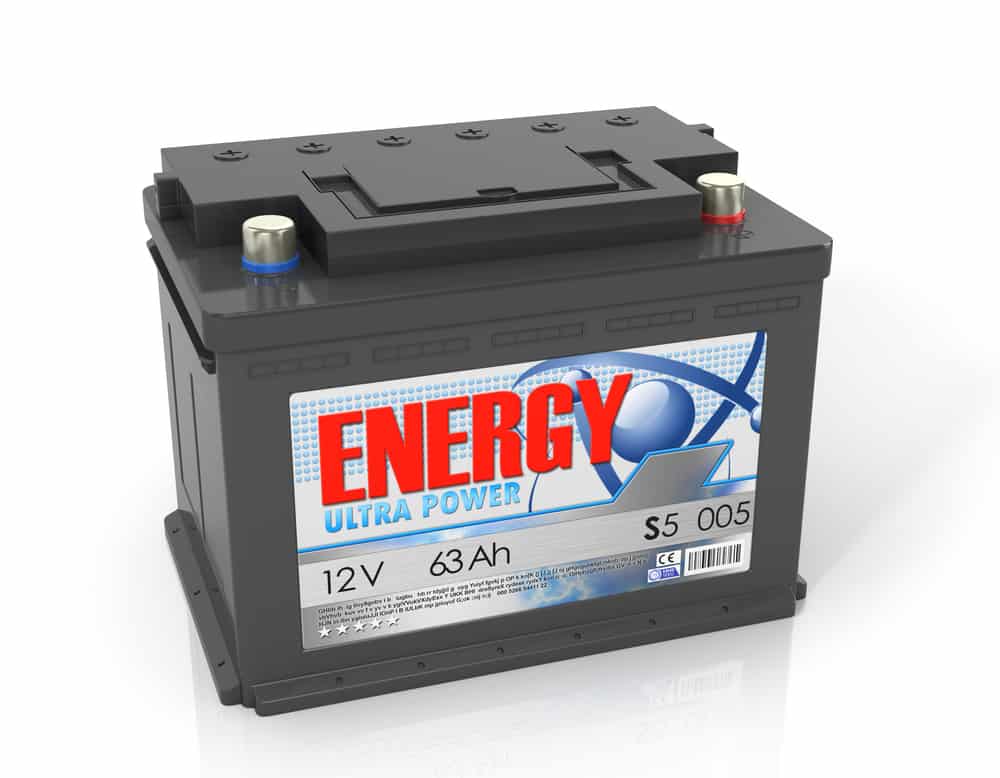Standard wet or saturated lead acid batteries (STD batteries) are popular automobile batteries, but not everyone is familiar with what separates them from other battery types. Despite the number in circulation, you may have avoided them completely depending on what you drive or other preferences.
Looking at the basics of battery composition, operation, and maintenance distinguish this standard battery type from similar alternatives. They also affect acceptable use for the battery, and STD batteries have plenty of advantages and disadvantages to consider.
This article explains the key characteristics of STD batteries and how they compare to other battery types. We recap on advantages and disadvantages that may help you decide which type of battery works better for certain applications.
Table of Contents
STD Battery Basics
While batteries operate in similar ways, there are a few key differences that set them worlds apart. For STD batteries, these include:
- Battery composition and design
- Required maintenance
- Charging
These details affect how you can use the battery, and STD batteries are better suited for certain tasks.
Composition and Design
STD batteries check a few boxes, meaning they are also known as or encompassed by:
- Flooded batteries
- Deep cycle batteries
- Lead-acid batteries
These batteries contain six cells, each with positive and negative plates, set apart with a separator and surrounded by electrolytes. STD batteries contain sulfuric acid and water to bump up the electrolytes, and you need to top this off regularly.
This is because STD batteries have an open design. Unlike the popular closed-cell and battery design, STD batteries have a vent that allows for the gasses to escape. This simpler design is cheaper, and it can last longer than sealed battery designs.
More on Lead-Acid Batteries
Lead-acid batteries were the first rechargeable battery used for commercial purposes, meaning they have a long history of use. They’re known for their dependability and cost-efficient design.
These batteries are made from a lead alloy. The other metals make the lead plates stronger, but lead to other problems. Antimony and tin improve deep-cycling properties but use up water faster, and calcium limits any self-discharge but magnifies the damage from overcharging.
Not all lead-acid batteries are STD batteries, but all batteries used in deep cycle applications are.
Maintenance
Because of the open design, the liquid in an STD battery must be topped off regularly to maintain operation and prevent damage to the battery. Failure to do this often enough, or refilling with anything other than distilled water, can ruin the battery.
You may also need to refill the battery if it spills during transportation or even operation. The water will splash out if the battery is tipped, so proper maintenance requires careful transportation and use.
These batteries require a more hands-on approach in all areas. Even smaller issues, like corrosion, can cause big problems down the line. Failure to clean or top off the battery can cut its lifespan in half or take it out completely.
Charging
Proper maintenance includes proper charging procedures. Flooded batteries are more finicky than other battery types, meaning you need to follow certain rules when recharging your batteries to preserve battery life.
To start, you must have the correct type of battery charger. Chargers will indicate whether they work with STD batteries, or you can search for the answer online.
The biggest issues related to STD battery charging relate to sulfation and excessive gassing.
Sulfation refers to a buildup of lead sulfate crystals on the charging plates. These interfere with charging, and will reduce capacity and life over time. The crystals come from the chemical composition of the battery and relate specifically to reactions from undercharging or overcharging.
Gassing occurs naturally, but overcharging leads to excess evaporation due to higher temperature of the electrolyte solution. This increases the pressure inside the battery, which exits through the vents, but can drop the solution level enough to damage the charge plates.
Charging an STD battery is not a simple plug and forget situation; it requires attention, or you may undo any benefits of the battery or even create a dangerous situation.
Uses

While they aren’t the most convenient to maintain or transport, STD batteries provide power to:
- Some automobiles (or accessories, like panel lights, gauges, or clocks and radios)
- Motorcycles
- Golf carts
In other situations, STD batteries store energy from solar panels and may operate in an emergency backup power system.
Their applicable use is limited by their likelihood to leak and their stringent maintenance schedule.
STD Batteries Compared to Different Battery Types
STD batteries may be one of the oldest rechargeable battery technologies, but they aren’t the only ones.
Other battery types include:
- AGM batteries
- Gel batteries
- Lithium batteries
These differ in both construction and composition, and they may suit other tasks better.
Absorbent Glass Mat (AGM) Batteries
The key difference between STD and AGM batteries is construction. Unlike the open design of an STD battery, AGM batteries are sealed and provide greater ease in use. This makes them spill-proof and eliminates the need for routine maintenance.
AGM batteries provide a deep discharge and recharge quickly without affecting their lifespan, making them a top choice for car batteries. They’re more expensive than STD batteries, but the peace of mind is worth it depending on the situation.
This is especially important when dealing with higher vibration levels that could upset the liquid electrolyte solution, even accidentally, such as with race cars. In these situations, the risk is not worth the rewards of an STD battery.
A common misconception is that you can use the same charger for either battery. Because AGM batteries do not deal with the sulfate crystal issue, they use a lower voltage charger.
This would be insufficient for an STD battery, and the STD charger may be too powerful
for the AGM battery.
Gel-Cell Batteries
Gel batteries are similar to AGM batteries, but they’re more flexible. Because they use dry cell technology you can mount them practically anywhere on your vehicle without worrying about spilling or maintaining the battery.
As far as deep cycle batteries go, gel batteries are extremely durable. They usually last longer than other deep cycle battery types, particularly in higher temperatures, but they’re more sensitive to overcharging.
Lithium Batteries and Lithium-Ion Batteries
Lithium batteries are not a deep cycle variety, but they’re a more modern take on automobile power. They cost more than lead-acid batteries, especially STD batteries, but last longer.
These batteries are smaller, lighter, and fit into tighter spaces (perfect for smaller vehicles). They have a slower discharge rate that may not work for more powerful applications, but operate well for general use.
While they still have “best practice” rules for charging, lithium ion batteries are not as sensitive. They also accept a faster current for charging, so they recharge faster and get the vehicle running again sooner.
General Advantages of STD Batteries
STD batteries are popular because of their cost and reliability.
The scope of these benefits varies depending on the manufacturer, but most STD batteries offer at least this much.
1. Cost
The cost of an STD battery is the most noticeable difference between this wet cell battery and its competition. While the lower price tag is not as convenient, it’s particularly attractive when you’re buying up multiple batteries.
For example, you could buy two or three STD batteries for the amount you would pay for a single AGM battery. Opting for STD batteries can literally cut your cost down to half or even one-third of the price.
2. Reliability

As long as you take care of an STD battery, you can count on them to keep you going. These batteries have a long history of use and subsequent modifications, and there is a reason they haven’t been completely run out by the competition.
If you’re the type of person who doesn’t mind the extra work or even likes the extra level of control, you may find STD batteries the better option.
General disadvantages of STD Batteries
In most cases, the open construction of an STD battery and the upkeep are enough to steer people away. All it takes is one accidental bump to knock it over and spill the solution.
Furthermore, you constantly worry about sulfate or overcharging with these batteries. While they perform well with proper maintenance, one mistake can cause a major problem.
These issues limit how you can use the battery. You can’t move them easily, and you must mount them securely in an upright position. Despite their reliability, they aren’t very versatile.
Conclusion
An STD battery has a long history of use, and it likely won’t go anywhere soon. While there are newer battery technologies on the market, many people still prefer the lower cost of these flooded batteries and don’t mind the maintenance requirement.
These batteries work well in most situations, especially for motorcycles and golf carts, and provide consumers with a cost effective power solution. As long as you take care of it and pay attention to your battery, you will get the power and performance you need.
Are you considering an STD battery for your power supply? Let us know what you need it for and what you expect in the comments!
